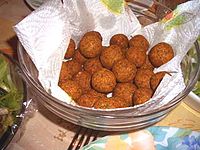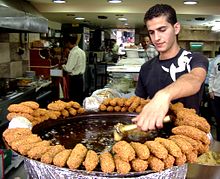Falafel: Difference between revisions
unexplained change. |
we discussed this before, unaffiliated translation. |
||
| Line 21: | Line 21: | ||
Generally accepted to have first been made in [[Egypt]], where the dish is widely known as {{lang|ar|طعمية}} (''{{transl|ar|ta'amiya}}'') in the [[Cairo]] dialect, falafel has become a dish eaten throughout the Middle East. The [[Copt]]s of Egypt claim to have first made the dish as a replacement for meat during Lent. The hearty fritters are now found around the world as a replacement for meat and as a form of [[street food]]. |
Generally accepted to have first been made in [[Egypt]], where the dish is widely known as {{lang|ar|طعمية}} (''{{transl|ar|ta'amiya}}'') in the [[Cairo]] dialect, falafel has become a dish eaten throughout the Middle East. The [[Copt]]s of Egypt claim to have first made the dish as a replacement for meat during Lent. The hearty fritters are now found around the world as a replacement for meat and as a form of [[street food]]. |
||
The Israeli appropriation of falafel |
The Israeli appropriation of falafel as a "national snack" has caused indignation among Palestinians and in parts of the Arab world who see the dish as authentically Arab.<ref>{{Cite book|title=The place of the Mediterranean in modern Israeli identity|series=Jewish identities in a changing world|volume=11|last=Nocke|first=Alexandra|publisher=BRILL|year=2009|isbn=9789004173248|page=125|postscript=<!-- Bot inserted parameter. Either remove it; or change its value to "." for the cite to end in a ".", as necessary. -->}}</ref> |
||
==Etymology== |
==Etymology== |
||
Revision as of 10:50, 23 January 2011
 Falafel balls | |
| Course | Street food |
|---|---|
| Region or state | Believed to have originated in Egypt before spreading north to the Levant |
| Serving temperature | Hot, served alone or in a pita |
| Main ingredients | Fava beans or chickpeas |
| Variations | many |
Falafel (/[invalid input: 'icon']fəˈlɑːfəl/; Arabic: فلافل, /[invalid input: 'ArFalafel.ogg'][invalid input: 'falāfil']/) is a ball or patty made from ground chickpeas and/or fava beans. Falafel is usually served in a pita, which acts as a pocket, or wrapped in a flatbread known as lafa. The falafel balls are topped with salads, pickled vegetables and hot sauce, and drizzled with tahini-based sauces. Falafel balls may also be eaten alone as a snack or served as part of a meze.
Generally accepted to have first been made in Egypt, where the dish is widely known as طعمية (ta'amiya) in the Cairo dialect, falafel has become a dish eaten throughout the Middle East. The Copts of Egypt claim to have first made the dish as a replacement for meat during Lent. The hearty fritters are now found around the world as a replacement for meat and as a form of street food.
The Israeli appropriation of falafel as a "national snack" has caused indignation among Palestinians and in parts of the Arab world who see the dish as authentically Arab.[1]
Etymology
The Arabic word فلافل (falāfil) is the plural of فلفل (filfil) 'hot pepper' also adjective denoting 'something fluffy',[2] probably from the Sanskrit word पिप्पल pippalī 'long pepper'.[3][4][5] The word has now spread to the European languages, Hebrew, and the rest of the world. The word falafel can now refer to the fritters themselves or to sandwiches filled with them.[6]
History

The origin of falafel is unknown and controversial.[6] A common theory is that the dish originates in Egypt,[7] possibly eaten by Copts as a replacement for meat during Lent.[8][9] Alexandria being a port city made it possible to export the dish and name to other areas in the Middle East.[10] Some authors even claim it dates to the pharaonic period.[11] The dish later migrated northwards to the Levant, where chickpeas replaced the fava.[12][13] It has been theorized to a lesser extent that falafel has origins in the Indian subcontinent where it and other chickpea-based dishes are also popular.[7][14] In recent years, the falafel debates have sometimes devolved into political discussions about the relationship between Arabs and Israelis.[12]
Falafel grew to become a common form of street food or fast food in the Middle East.[15] During Ramadan, falafel balls are sometimes eaten as part of the iftar, the meal that breaks the daily fast after sunset.[16] Falafel became so popular that McDonald's began to serve a "McFalafel" in some countries.[17]
While falafel is not a specifically Jewish dish, it was eaten by Mizrahi Jews in their countries of origin.[6][12] Later, it was adopted by early Jewish immigrants to Palestine.[18] The custom of eating falafel in a pita stuffed with salads began in Israel.[7][19] Falafel is now an iconic part of Israeli cuisine and often referred to as a national dish.[18] In Israel, falafel crosses ethnic and religious bounds, and is enjoyed by all sectors of society.[6]This has led to resentment by Palestinians and assertions of copyright infringement by the Lebanese Industrialists' Association.[13][20] Lebanon and Israel have been engaged in an escalating gastronomic battle often described as a "food fight," in which falafel, hummus and tabbouleh are used as ammunition.[21]
Israeli entrepreneurs brought falafel to Europe and the United States sometime in the 1970s.[7] Today, falafel is eaten all over the world.[22] It is popular among vegetarians, and prepackaged mixes are sold in health-food and grocery stores.[23] These days falafel-inspired burgers made of chickpea are eaten as a kind of veggie burger.[24]
On May 9, 2010, in Beirut, more than 300 Lebanese chefs prepared 5,173 kilograms (11,405 lb) falafel mixture. A Guinness World Records representative was present to record the feat.[25] On May 21, 2010, an Israeli chef in New York set a world record for the largest falafel ball, weighing in at 10.9 kilograms (24 lb) and with a circumference of more than a meter (3.3 ft). It was reported the ball is expected to enter the Guinness Book of World Records.[26]
Variations
Falafel is made from fava beans or chickpeas or a combination of the two. The Egyptian variety uses fava beans, while the use of chickpeas is predominant in other Middle Eastern countries.[27] Being derived from the Arabic word for nourishment, falafel is known as Arabic: طعمية [tˤaʕˈmijːa] in most of Egypt.[16][28] Palestinians and Yemenite Jews in Jerusalem have historically prepared falafel only from chickpeas.[29][30] The beans are not cooked prior to use. Instead they are soaked with baking soda, then ground together with various ingredients including onion, parsley, sesame seeds, and spices such as cumin and coriander. The mixture is shaped into balls or patties. This can be done by hand or with a tool called an aleb falafel.[27][28] The mixture is then deep fried.
Egyptian falafel is usually made from fava beans, although it may also be made from chickpeas, and is often quite spicy. Typically garlic, scallions, leeks and onions are part of the mixture as well as pepper. The Alexandria version uses generous quantities of cayenne pepper. Egyptian Falafel is normally served on a whole wheat pita bread with salad and tahini sauce or a parsley-tahini sauce called bakdooniseya.[31][32]
In Arab countries a round khubz, 'eish' in Egypt, is halved and used to create a cigar-shaped wrap. In Arab countries, hummus is rarely added to falafel. Tahini thinned with water and lemon is more common. In Lebanon, the popular salad called tabbouleh could be eaten alongside falafel and many other dishes, because it is also a part of the meze. Pickled cucumber or chilies, turnip (colored pink with beetroot), and raw onion are common falafel accompaniments. Sumac is very commonly used with falafel in Syria.[33] In Israel, Jordan, and the United Arab Emirates, French fries may be added to the sandwich.[33][34]
Nutrition
When made with chickpeas, falafel is high in protein, complex carbohydrates, and fiber.[35] Chickpeas are also low in fat and salt and contain no cholesterol. Key nutrients are calcium, iron, magnesium, phosphorus, potassium, zinc, copper, manganese, Vitamin C, thiamine, pantothenic acid, Vitamin B, and folate. Phytochemicals include beta-carotene.[36]
Falafel is hearty enough to replace hamburger patties and meatballs in vegetarian dishes.[23] Falafel can be baked to reduce the fat content associated with frying, but doing so will alter the texture and flavor.[35][37]
References
- ^ Nocke, Alexandra (2009). The place of the Mediterranean in modern Israeli identity. Jewish identities in a changing world. Vol. 11. BRILL. p. 125. ISBN 9789004173248.
- ^ Encyclopedia of Jewish Food By Gil Marks, page 183
- ^ Define: falafel
- ^ The American Heritage Dictionary of the English Language, 4th ed. Boston: Houghton Mifflin, 2000, s.v. falafel
- ^ Morton, Mark (2000). Cupboard Love: A Dictionary of Culinary Curiosities (2 ed.). Insomniac Press. p. 124. ISBN 1894663667. Retrieved April 27, 2010.
- ^ a b c d Slow food: collected thoughts on taste, tradition, and the honest pleasures ... By Carlo Petrini, Benjamin Watson, Chapter Four, Page 55
- ^ a b c d Falafel fact sheet
- ^ Yael Raviv, "Falafel: A National Icon" Gastronomica Summer 2003 doi:10.1525/gfc.2003.3.3.20
- ^ Denker, Joel (2003). The World on a Plate: A Tour Through the History of America's Ethnic Cuisine. U of Nebraska Press. p. 41. ISBN 0813340039.
- ^ Green, Aliza (2004). Beans. Running Press. p. 76. ISBN 9780762419319.
- ^ Egyptian food and drink, By Hilary Wilson, page 25
- ^ a b c Jodi Kantor (July 10, 2002). "A History of the Mideast in the Humble Chickpea". The New York Times. Retrieved 2008-03-23.
{{cite web}}: Italic or bold markup not allowed in:|publisher=(help) - ^ a b MacLeod, Hugh (October 12, 2008). "Lebanon turns up the heat as falafels fly in food fight". The Age. Retrieved February 10, 2010.
- ^ Sussman, Anna (August 16, 2007). "A Lebanese chef's vision: Make falafel, not war". The New York Times. Retrieved March 6, 2010.
- ^ Kelley, Leigh (January 28, 2010). "Dining with a Middle Eastern flair". Times-News. Retrieved February 10, 2010.
- ^ a b Habeeb, Salloum (April 1, 2007). "Falafel: healthy Middle Eastern hamburgers capture the West". Vegetarian Journal. Retrieved February 16, 2010.
- ^ "Post pint perfection". Ulster Herald. June 28, 2007. Retrieved February 16, 2010. [dead link]
- ^ a b Pilcher, Jeffrey M. (2006). Food in World History. Routledge. p. 115. ISBN 9780415311465.
- ^ On the trail of Israeli falafel
- ^ Nahmias, Roee (June 10, 2008). "Lebanon: Israel stole our falafel". Ynet News. Retrieved February 11, 2010.
- ^ 10-Tonne Hummus Victory In Lebanon-Israel's Gastronomy Wars
- ^ Hendler, Sefi (August 16, 2007). "Falafel takes over the world". Ynetnews. Retrieved February 10, 2010.
- ^ a b Wolfe, Frankie Avalon (2007). The Complete Idiot's Guide to Being Vegetarian. Penguin Group. pp. 175, 186. ISBN 978-1-592-57682-1.
- ^ The Great Big Burger Book: 100 New and Classic Recipes for Mouth Watering ... Jane Murphy, p.304
- ^ Lebanese chefs load up with falafel for Israel food fight
- ^ Israeli chef rolls into the record books with largest falafel ball.
- ^ a b Campion, Charles (May 9, 2002). "Falling for fine falafel". London Evening Standard. Retrieved February 10, 2010.
- ^ a b Davidson, Alan (2006). The Oxford companion to food (2 ed.). Oxford University Press. p. 287. ISBN 9780192806819. Retrieved April 27, 2010.
{{cite book}}: Unknown parameter|coauthors=ignored (|author=suggested) (help) - ^ About Israel's signature food--plus, a recipe.
- ^ Ayto, John (1990). The glutton's glossary: a dictionary of food and drink terms. Routledge. ISBN 0415026474, 9780415026475.
{{cite book}}: Check|isbn=value: invalid character (help); More than one of|author=and|last1=specified (help) - ^ Egyptian Falafel Recipe
- ^ Bakdooniseya Sauce
- ^ a b theepicentre
- ^ The History of Falafel
- ^ a b Webb, Robyn (2004). Eat to Beat High Blood Pressure. Readers Digest. p. 140. ISBN 9780762105083. Retrieved April 28, 2010.
- ^ Balch, Phyllis A. (2003). Prescription for Dietary Wellness (2 ed.). Avery. p. 119. ISBN 9781583331477. Retrieved April 28, 2010.
- ^ Winget, Mary (2003). Cooking the North African Way (2 ed.). Twenty-First Century Books. p. 33. ISBN 9780822541691. Retrieved April 28, 2010.
{{cite book}}: Unknown parameter|coauthors=ignored (|author=suggested) (help)
